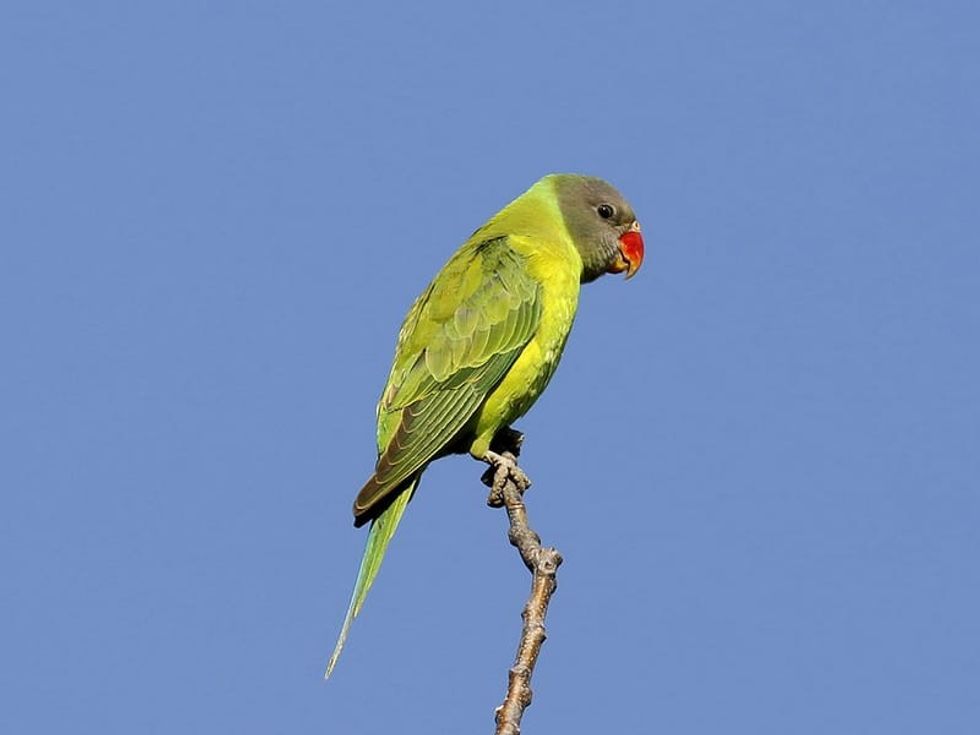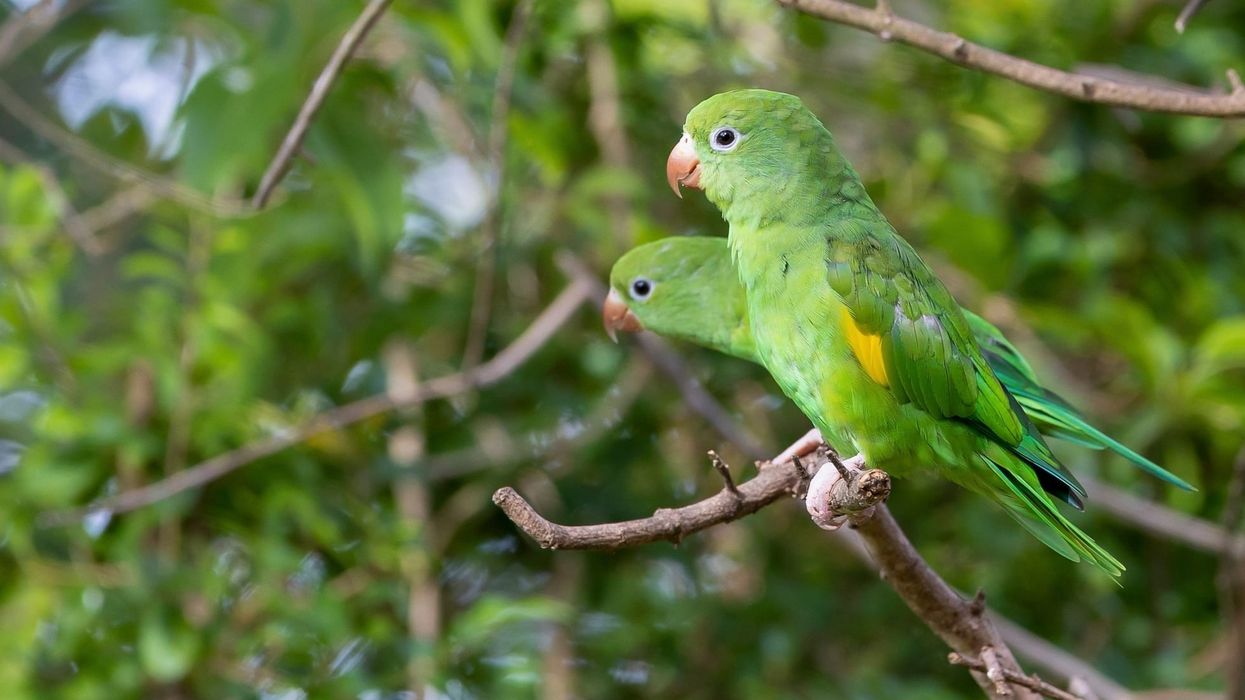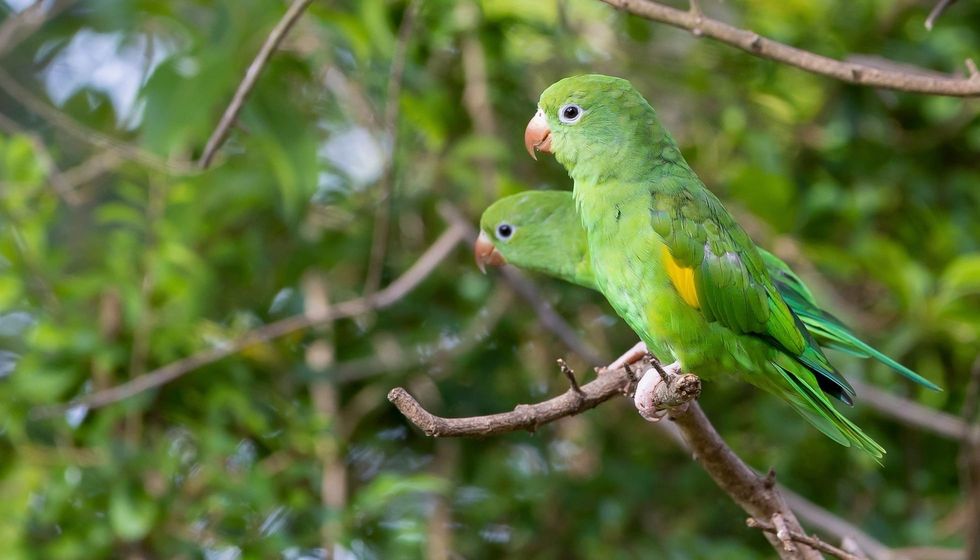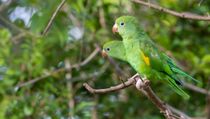Fun Plain Parakeet Facts For Kids

The plain parakeet (Brotogeris tirica) is one of the most widely known species of parakeet that is predominantly found in the Southern and Eastern parts of the country Brazil.
The astonishing fact about the plain parakeet (Brotogeris tirica) is that despite its natural habitat being lowland forests and heavily vegetative areas, it seems to have acclimatized to the urban areas and suburban areas that have taken over its natural habitats without a hiccup.
The plain parakeet remains to be one of the most commonly sighted birds and most noticeable due to the loud noise by these common urban parrots.
Keep reading to find out more about this bird of America that has gradually also become a popular pet to have due to its high intelligence quotient. After reading these fascinating facts about the most common parrot species in urban areas, do check the other articles on the Carolina parakeet and Monk parakeet.
Plain Parakeet Interesting Facts
What type of animal is a plain parakeet?
The plain parakeet (Brotogeris tirica) is a type of bird. This Brazilian parakeet (family Psittacidae, genus Brotogeris, species Brotogeris tirica) can be found living among its species and people also keep parakeets as pets. The natural habitat for these common parrots is scattered woodlots and patches of secondary growth but it has adapted well to urban living as well.
What class of animal does a plain parakeet belong to?
The plain parakeet is essentially a bird that is classified under the biological classification of Aves because it has feathers, a beak, a vertebrate column, and the fact that these parakeets lay eggs as a manner of reproduction. This common and active bird species from Brazil belongs to the family Psittacidae, genus Brotogeris, species Brotogeris tirica.
How many plain parakeets are there in the world?
The number of plain parakeets in Brazil has seen an obvious decline due to the loss of their natural habitat to either agricultural settlements or urban settlements.
However, despite this, the population trend seems to hold stable for the species which is why it has been classified as a species of Least Concern in Brazil concerning its conservation status, by the IUCN.
However, there is a dearth and loads of data regarding the number of plain parakeets in the world, and therefore, no specific number of plain parakeets in the world is known.
Where does a plain parakeet live?
A plain parakeet (family Psittacidae, genus Brotogeris, species Brotogeris tirica) naturally lives in scattered woodlots and patches of secondary growth but over the years, the species has been domesticated and now can be found as a pet bird in many houses.
This green parrot species is most predominantly found in the Southern and Eastern parts of the country of Brazil.
They prefer to nest in tree hollows.
What is a plain parakeet's habitat?
A plain parakeet's (Brotogeris tirica) natural habitat is the rainforests of Brazil and other secondary and heavily wooded forests in the country. These parakeets from the family Psittacidae, genus Brotogeris, species Brotogeris tirica are also known to live in lowland forests or areas with plenty of vegetation.
The plain parakeet prefers to be at elevations of about 4000-4200 ft (1200-1300 m). The parakeet population has been increasingly noticed in urban areas which have plenty of vegetation cover and a variety of perches.
Who do plain parakeets live with?
The plain parakeet (Brotogeris tirica) generally lives in flocks or pairs throughout their lives. However, since the plain parakeet has also been domesticated, today it is also commonly found as a pet bird in many households.
How long does a plain parakeet live?
The average expected lifespan of a plain parakeet (Brotogeris tirica) is about 15 years in its natural habitat. This green parrot might live for slightly longer in captivity.
How do they reproduce?
The average plain parakeet (Brotogeris tirica) becomes capable of breeding at the age of six months. However, most plain parakeets only mate after attaining about 10 months to one year of age.
Breeding season for the plain parakeet begins in April and extends through May wherein, males and females find a mate and engage in the process of reproduction.
The female plain parakeet generally lays a clutch of three to six eggs which are incubated for about 2.5 weeks or about 17-20 days after which the chicks hatch out of their eggs. The chicks grow rapidly and attain their adult dimensions almost after only two months of having hatched.
What is their conservation status?
The plain parakeet (Brotogeris tirica) is classified as a species of Least Concern in terms of its conservation status. However, the population of plain parakeets has seen a notable descent due to the loss of its natural habitat of forests to urban, suburban settlements and agricultural lands.
Even though plain parakeets seem to have adjusted to their new surroundings and their population count seems to be holding stable for now, the most imminent danger to this green parrot species is the loss of its natural habitat.
Plain Parakeet Fun Facts
What do plain parakeets look like?
The wild plain parakeet (Brotogeris tirica) is not a very large bird.
Its color is a bright green with a grayish ring around its eyes and a downward curved beak which is generally brownish or pink in color. The primary feathers and outer secondary feathers are edged with green and brown around the bend of the wing and lesser wing covert.
The wings of this green parrot species are of a darker shade of green with shades of yellow as compared to the rest of its plumage and its feet are a contrasting darker color.

*Please note that this is an image of a Grey-headed Parakeet, not a Plain Parakeet specifically. If you have an image of a Plain Parakeet, then please let us know at hello@kidadl.com.
How cute are they?
The plain parakeet is an extremely sociable bird with a highly playful personality that does not shy away from socializing with human beings. These factors put together make the plain parakeet an extremely cute bird.
How do they communicate?
The plain parakeet generally makes use of raucous calls which generally have two distinct syllables. Even though the plain parakeet has not been known to be consistently noisy, their calls are usually very loud and harsh.
One aspect of the plain parakeet that sets it apart from other birds and animals is its ability to learn the human language and use it to communicate.
How big is a plain parakeet?
The plain parakeet is a fairly small species of bird that only grows to be about 9-10 in (22.8-25.4 cm) long in terms of size with a wingspan of 17-19 in (43.1-48.2 cm). They are a little bigger than Budgerigar.
How fast can a plain parakeet fly?
The answer to this question is not a straightforward one since the top speed of a plain parakeet’s flight has never been recorded. However, some sources say that the parakeet can generally fly at speeds of about 26 mph (41.8 kph). Nonetheless, there isn’t enough data to establish conclusively the speed of flight of the plain parakeet.
How much does a plain parakeet weigh?
A plain parakeet (Brotogeris tirica) is a fairly small bird species that has a light skeletal structure that is appended by its long tail that helps it in its flight to change direction or altitude. These green parrots' weight range is around 2.2-2.3 oz (0.062-0.065 kg).
What are the male and female names of the species?
A male plain parakeet is usually referred to as the cock whereas a female plain parakeet is referred to as a hen.
What would you call a baby plain parakeet?
A baby parakeet is generally referred to as a chick, like most other young birds of this species.
What do they eat?
Plain parakeets have been known to feast on a predominantly vegetarian food diet including seeds of different kinds, various types of nuts, fruits such as wild berries, figs, and the likes of such algae, and even different parts of the anatomy of a flower.
However, these green parrots have also been seen to feed on some types of insects and their larvae for their food requirements.
When kept as pets, these common urban parrots of Brazil must be fed fruits, mixed seeds, sprouted sunflower seeds, cooked beans, boiled vegetables, and pulses along with seed mixes for a balanced diet.
Are they dangerous?
No, these green parrots are not dangerous birds. On the contrary, the plain parakeet has been known to be an extremely friendly bird that has little to no issues with socializing with human beings. These green parrots also have a jovial and playful nature about them and only will attempt to peck any human being if it feels threatened.
Would they make a good pet?
The plain parakeet is kept as a solo pet in many parts of the world because it is an extremely sociable species that enjoys interacting with human beings and likes being petted.
The main reason why the parakeet is kept as a pet is its ability to learn the human language and use it to communicate.
If you do plan on keeping it as a pet then it is best to give it some area to fly around instead of clipping its wings and keeping it confined to a cage since ultimately it is a bird that needs to fly.
The cage must be equipped with a variety of perches.
This wild parrot must be fed a healthy diet comprising of fruits like bananas, mix seeds, sprouted sunflower seeds, cooked beans, boiled vegetables, and pulses along with any vet-recommended foods and seed mixes. Seeds must make only a portion of the diet and attention should be paid to a pelleted diet as well.
An average plain parakeet will cost you about $10-$60.
Did you know...
The most common diseases and health issues faced by the plain parakeet are avian tuberculosis, chlamydiosis, bacterial hepatitis, avian gout, and so on.
These parakeets are afraid of darkness.
These birds require adequate space when in captivity as well as a regular feeding pattern. There is no need to cover these birds at night as they only need a dark and quiet area to sleep in.
Should I let my parakeet fly around the house?
Yes, you can let your parakeet fly around the house as long as you can afford to be vigilant enough to ensure it doesn’t get stuck or get into fights with other larger birds in your surroundings.
Moreover, certain precautions should be taken before you let it free in your house such as keeping tiny objects out of sight since the birds could swallow these objects and choke. It is best to not allow your parakeet inside your kitchen.
It is advisable to have a cage for them at night since it also offers them a sense of security at night and you can ensure that the parakeet does not get into physical trouble while you’re sleeping.
Do plain parakeets talk?
Yes, plain parakeets can be taught to speak the human language with a healthy amount of training.
The best way to start is to get a parakeet when it is still young and talk to it by using a set phrase that can be repeated multiple times. Make use of psychological techniques of positive reinforcement while training it by offering treats or triggers.
It is not ideal to make use of audio recording to train your birds to speak since in those cases, the bird only learns what to say but does not learn communication.
Here at Kidadl, we have carefully created lots of interesting family-friendly animal facts for everyone to discover! Learn more about some other birds from our Alexandrine parakeet surprising facts and eared grebe fun facts for kids pages.
You can even occupy yourself at home by coloring in one of our parakeet flying coloring pages.
We Want Your Photos!
More for You
See All
Bachelor of Science specializing in Computer Science

Christian MbaBachelor of Science specializing in Computer Science
Christian Mba is an experienced blogger and content writer with over a decade of experience. He holds a Bachelor of Science degree in Computer Science from Nigeria and has a keen interest in Python programming. Along with his writing and blogging expertise, he is also an SEO specialist with more than six years of experience. Chris, as he is commonly known, has a passion for music and enjoys playing the piano.
Bachelor of Science specializing in Systems Engineering

Oluwapelumi IwayemiBachelor of Science specializing in Systems Engineering
Iwayemi is a creative content writer and editor studying for a Bachelor of Science specializing in Systems Engineering from the University of Lagos. He is skilled in research and has experience writing and editing content for different organizations.
Disclaimer
1) Kidadl is independent and to make our service free to you the reader we are supported by advertising. We hope you love our recommendations for products and services! What we suggest is selected independently by the Kidadl team. If you purchase using the Buy Now button we may earn a small commission. This does not influence our choices. Prices are correct and items are available at the time the article was published but we cannot guarantee that on the time of reading. Please note that Kidadl is a participant in the Amazon Services LLC Associates Program, an affiliate advertising program designed to provide a means for sites to earn advertising fees by advertising and linking to Amazon. We also link to other websites, but are not responsible for their content.
2) At Kidadl, we strive to recommend the very best activities and events. We will always aim to give you accurate information at the date of publication - however, information does change, so it’s important you do your own research, double-check and make the decision that is right for your family. We recognise that not all activities and ideas are appropriate for all children and families or in all circumstances. Our recommended activities are based on age but these are a guide. We recommend that these ideas are used as inspiration, that ideas are undertaken with appropriate adult supervision, and that each adult uses their own discretion and knowledge of their children to consider the safety and suitability. Kidadl cannot accept liability for the execution of these ideas, and parental supervision is advised at all times, as safety is paramount. Anyone using the information provided by Kidadl does so at their own risk and we can not accept liability if things go wrong.
3) Because we are an educational resource, we have quotes and facts about a range of historical and modern figures. We do not endorse the actions of or rhetoric of all the people included in these collections, but we think they are important for growing minds to learn about under the guidance of parents or guardians.







